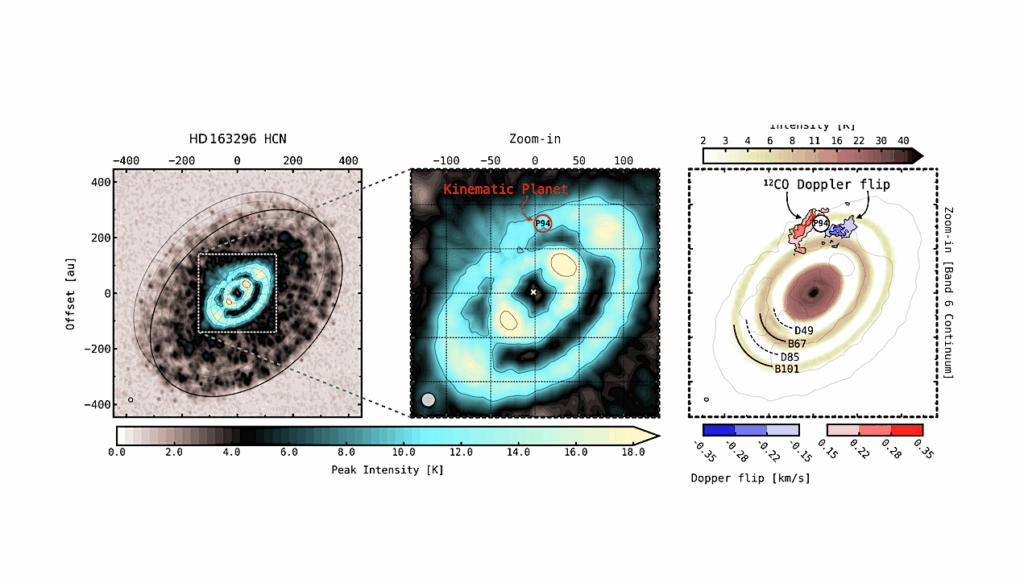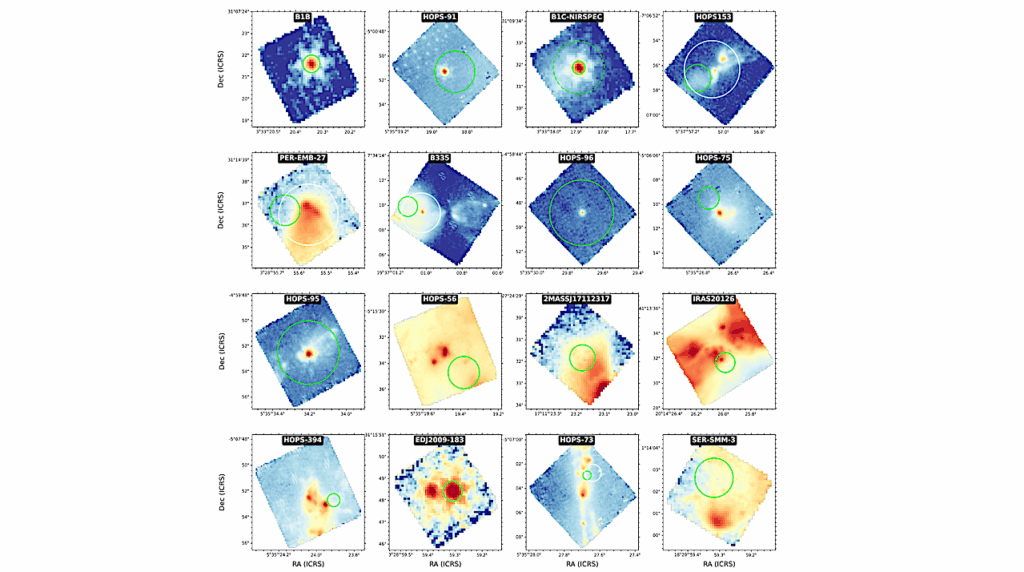Presolar Stardust In Asteroid Ryugu

Image: a) Backscattered electron (BSE) image of Ryugu thin section A0058-2. Every black area consists of ~20 NanoSIMS maps measured. b) An area in section C0002 with a less-altered lithology than the surrounding Ryugu matrix (“clast 1”; BSE image). This area contains Mgrich olivine, low-Ca pyroxenes and spinel grains with sizes up to ~15 µm (Kawasaki et al. 2022). Two of three O-anomalous grains identified in Ryugu, including one likely presolar silicate (g–h), were found in this region. c–e) Secondary electron (SE) image of a Ryugu particle pressed into gold foil in which two presolar SiC grains were detected. The Canomalous regions, indicated by the white arrows, are clearly associated with 28Si hotspots. f) 17O-rich presolar oxide found in Ryugu A0058-2 matrix. g–h) This O-anomalous presolar grain was found in the less-altered area shown in (b). The inlet in (g) shows a δ18O sigma image in which every pixel represents the number of standard deviations from the average values. The grain is probably a presolar silicate as Si is present in the EDX map, and Al was neither detected in the EDX map nor the NanoSIMS ion image, unlike the adjacent spinel (MgAl2O4), purple in color in (h).
We have conducted a NanoSIMS-based search for presolar material in samples recently returned from C-type asteroid Ryugu as part of JAXA’s Hayabusa2 mission.
We report the detection of all major presolar grain types with O- and C-anomalous isotopic compositions typically identified in carbonaceous chondrite meteorites: 1 silicate, 1 oxide, 1 O-anomalous supernova grain of ambiguous phase, 38 SiC, and 16 carbonaceous grains. At least two of the carbonaceous grains are presolar graphites, whereas several grains with moderate C isotopic anomalies are probably organics.
The presolar silicate was located in a clast with a less altered lithology than the typical extensively aqueously altered Ryugu matrix. The matrix-normalized presolar grain abundances in Ryugu are 4.8+4.7−2.6 ppm for O-anomalous grains, 25+6−5 ppm for SiC grains and 11+5−3 ppm for carbonaceous grains. Ryugu is isotopically and petrologically similar to carbonaceous Ivuna-type (CI) chondrites.
To compare the in situ presolar grain abundances of Ryugu with CI chondrites, we also mapped Ivuna and Orgueil samples and found a total of SiC grains and 6 carbonaceous grains. No O-anomalous grains were detected.
The matrix-normalized presolar grain abundances in the CI chondrites are similar to those in Ryugu: 23 +7−6 ppm SiC and 9.0+5.3−4.6 ppm carbonaceous grains.
Thus, our results provide further evidence in support of the Ryugu-CI connection. They also reveal intriguing hints of small-scale heterogeneities in the Ryugu samples, such as locally distinct degrees of alteration that allowed the preservation of delicate presolar material.
Jens Barosch, Larry R. Nittler, Jianhua Wang, Conel M. O’D. Alexander, Bradley T. De Gregorio, Cécile Engrand, Yoko Kebukawa, Kazuhide Nagashima, Rhonda M. Stroud, Hikaru Yabuta, Yoshinari Abe, Jérôme Aléon, Sachiko Amari, Yuri Amelin, Ken-ichi Bajo, Laure Bejach, Martin Bizzarro, Lydie Bonal, Audrey Bouvier, Richard W. Carlson, Marc Chaussidon, Byeon-Gak Choi, George D. Cody, Emmanuel Dartois, Nicolas Dauphas, Andrew M. Davis, Alexandre Dazzi, Ariane Deniset-Besseau, Tommaso Di Rocco, Jean Duprat, Wataru Fujiya, Ryota Fukai, Ikshu Gautam, Makiko K. Haba, Minako Hashiguchi, Yuki Hibiya, Hiroshi Hidaka, Hisashi Homma, Peter Hoppe, Gary R. Huss, Kiyohiro Ichida, Tsuyoshi Iizuka, Trevor R. Ireland, Akira Ishikawa, Motoo Ito, Shoichi Itoh, Kanami Kamide, Noriyuki Kawasaki, A. L. David Kilcoyne, Noriko T. Kita, Kouki Kitajima, Thorsten Kleine, Shintaro Komatani, Mutsumi Komatsu, Alexander N. Krot, Ming-Chang Liu, Zita Martins, Yuki Masuda, Jérémie Mathurin, Kevin D. McKeegan, Gilles Montagnac, Mayu Morita, Smail Mostefaoui, Kazuko Motomura, Frédéric Moynier, Izumi Nakai, Ann N. Nguyen, Takuji Ohigashi, Taiga Okumura, Morihiko Onose, Andreas Pack, Changkun Park, Laurette Piani, Liping Qin, Eric Quirico, Laurent Remusat, Sara S. Russell, Naoya Sakamoto, Scott A. Sandford, Maria Schönbächler, Miho Shigenaka, Hiroki Suga, Lauren Tafla, Yoshio Takahashi, Yasuo Takeichi, Yusuke Tamenori, Haolan Tang, Kentaro Terada, Yasuko Terada, Tomohiro Usui, Maximilien Verdier-Paoletti, Sohei Wada, Meenakshi Wadhwa, Daisuke Wakabayashi, Richard J. Walker, Katsuyuki Yamashita, Shohei Yamashita, Qing-Zhu Yin, Tetsuya Yokoyama, Shigekazu Yoneda et al. (24 additional authors not shown)
Comments: 12 pages, 3 figures, 2 tables. Published in ApJL
Subjects: Earth and Planetary Astrophysics (astro-ph.EP); Solar and Stellar Astrophysics (astro-ph.SR)
Cite as: arXiv:2208.07976 [astro-ph.EP] (or arXiv:2208.07976v1 [astro-ph.EP] for this version)
https://doi.org/10.48550/arXiv.2208.07976
Focus to learn more
Journal reference: 2022, The Astrophysical Journal Letters, 935, L3 (12pp)
Related DOI:
https://doi.org/10.3847/2041-8213/ac83bd
Focus to learn more
Submission history
From: Larry Nittler
[v1] Tue, 16 Aug 2022 22:29:35 UTC (4,250 KB)
Full Paper: https://arxiv.org/abs/2208.07976
Astrobiology, Astrochemistry,








